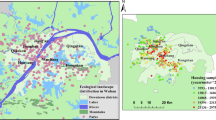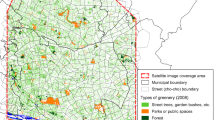Abstract
Hedonic prices of landscape are estimated in the urban fringe of Dijon (France). Viewshed and its content as perceived at ground level are analyzed from satellite images supplemented by a digital elevation model. Landscape attributes are then fed into econometric models (based on 2,667 house sales) that allows for endogeneity, multicollinearity, and spatial correlations. Results show that when in the line of sight, trees and farmland in the immediate vicinity of houses command positive prices and roads negative prices; if out of sight, their prices are markedly lower or insignificant: the view itself matters. The layout of features in fragmented landscapes commands positive hedonic prices. Landscapes and features in sight but more than 100–300~m away all have insignificant prices.
Similar content being viewed by others
References
Anselin L, Lozano-Garcia N (2008) Errors in variables and spatial effects in hedonic house price models of ambient air quality. Empir Econ 34(1): 5–34
Bastian CT, McLeod DM, Germino MJ, Reiners WA, Blasko BJ (2002) Environmental amenities and agricultural land values: a hedonic model using geographic information systems data. Ecolog Econ 40: 337–349
Bateman IJ, Jones AP, Lovette AA, Lake IR, Day BH (2002) Applying geographical information systems (GIS) to environmental and resource economics. Environ Resour Econ 22: 219–269
Bolitzer B, Netusil NR (2000) The impact of open spaces on property values in Portland, Oregon. J Environ Manage 59: 185–193
Brown JN, Rosen HS (1982) On the estimation of structural hedonic price models. Econometrica 50(3): 765–768
Cavailhès J (2005) Le prix des attributs du logement. Economie et Statistique 381(382): 91–123
Cheshire P, Sheppard S (1995) On the price of land and the value of amenities. Economica 62: 247–267
Day B, Bateman I, Lake I (2007) Beyond implicit prices: recovering theoretically consistent and transferable values for noise avoidance from a hedonic property price model. Environ Resour Econ 37: 211–232
Epple D (1985) Hedonic prices and implicit markets: estimating demand and supply functions for differentiated products. J Polit Econ 95: 59–80
Garrod GD, Willis KG (1992) Valuing goods’ characteristics: an application of the hedonic price method to environmental attributes. J Environ Manage 34: 59–76
Geoghegan J, Wainger LA, Bockstael NE (1997) Spatial landscape indices in a hedonic framework: an ecological economics analysis using GIS. Ecolog Econ 23: 251–264
Germino MJ, Reiners WA, Blasko BJ, McLeod D, Bastian CT (2001) Estimating visual properties of rocky mountain landscapes using GIS. Landsc Urban Plan 53: 71–83
Gobster PH, Chenoweth RE (1989) The dimensions of aesthetics preference: a quantitative analysis. J Environ Manage 29: 47–72
Hanley N, Wright RE, Adamowicz V (1998) Using choice experiments to value the environment. Environ Resour Econ 11: 413–428
Irwin EG (2002) The effects of open space on residential property values. Land Econ 78: 465–480
Irwin EG, Bockstael NE (2001) The problem of identifying land cover spillovers: measuring the effects of open space on residential property values. Am J Agr Econ 83: 698–704
Johnston RJ, Swallow SK, Bauer DM (2002) Spatial factors and stated preference values for public goods: considerations for rural land use. Land Econ 78: 481–500
Joly D, Brossard T, Cavailhès J, Hilal M, Tourneux FP, Tritz C, Wavresky P (2009) A quantitative approach to the visual evaluation of landscape. Ann Assoc Am Geogr 99(2): 292–308
Kaplan R, Kaplan S, Bown T (1989) Environmental preferences. A comparison of four domains of predictors. Environ Behav 21: 509–530
Kestens Y, Thériault M, des Rosiers F (2004) The impact of surrounding land cover and vegetation on single-family house prices. Environ Plan B 31: 539–567
Lake IR, Lovett AA, Bateman IJ, Langford IH (1998) Modelling environmental influences on property prices in an urban environment. Comput Environ Urban Syst 22: 121–136
McGarigal K, Cushman SA, Neel MC, Ene E (2002) Fragstats: spatial pattern analysis program for categorical maps. Computer software program produced by the authors at the University of Massachusetts, Amherst
McGarigal K, Marks B (1995) Fragstats: spatial pattern analysis program for quantifying landscape structure, Technical Report PNW-GTR-351, Portland
Mahan BL, Polasky S, Adams RM (2000) Valuing urban wetlands: a property price approach. Land Econ 76: 100–113
Paterson RW, Boyle KJ (2002) Out of sight, out of mind? Using GIS to incorporate visibility in hedonic property value models. Land Econ 78: 417–425
Roe B, Irwin EG, Morrow-Jones HA (2004) The effects of farmland, farmland preservation, and other neighborhood amenities on housing values and residential growth. Land Econ 80: 55–75
Rosen S (1974) Hedonic prices and implicit markets: product differentiation in pure competition. J Polit Econ 82: 34–55
Sheppard S (1999) Hedonic analysis of housing markets. In: ES Mills, P Cheshire (eds) Handbook of regional and urban economics. Applied Urban Economics, pp. 1595–1635
Smith VK, Poulos C, Kim H (2002) Treating open space as an urban amenity. Resour Energy Econ 24: 107–129
Spalatro F, Provencher B (2001) An analysis of minimum frontage zoning to preserve lakefront amenities. Land Econ 77: 469–481
Thorsnes P (2002) The value of a suburban forest preserve: estimates from sales of vacant residential building lots. Land Econ 78: 426–441
Tyrväinen LA, Miettinen A (2000) Property prices and urban forest amenities. J Environ Econ Manage 39: 205–223
Willis KG, Garrod GD (1993) Valuing landscape: a contingent valuation approach. J Environ Manage 37: 1–22
Author information
Authors and Affiliations
Corresponding author
Additional information
This research was financed by Burgundy Regional Council, Côte-d’Or Departmental Council and Dijon Conurbation Joint Councils. It uses data on real-estate transactions from the PERVAL Corporation.
Rights and permissions
About this article
Cite this article
Cavailhès, J., Brossard, T., Foltête, JC. et al. GIS-Based Hedonic Pricing of Landscape. Environ Resource Econ 44, 571–590 (2009). https://doi.org/10.1007/s10640-009-9302-8
Received:
Accepted:
Published:
Issue Date:
DOI: https://doi.org/10.1007/s10640-009-9302-8




